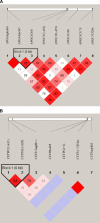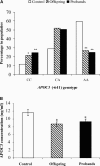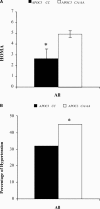Lipoprotein genotype and conserved pathway for exceptional longevity in humans
- PMID: 16602826
- PMCID: PMC1413567
- DOI: 10.1371/journal.pbio.0040113
Lipoprotein genotype and conserved pathway for exceptional longevity in humans
Abstract
Alteration of single genes involved in nutrient and lipoprotein metabolism increases longevity in several animal models. Because exceptional longevity in humans is familial, it is likely that polymorphisms in genes favorably influence certain phenotypes and increase the likelihood of exceptional longevity. A group of Ashkenazi Jewish centenarians (n = 213), their offspring (n = 216), and an age-matched Ashkenazi control group (n = 258) were genotyped for 66 polymorphisms in 36 candidate genes related to cardiovascular disease (CVD). These genes were tested for association with serum lipoprotein levels and particle sizes, apolipoprotein A1, B, and C-3 levels and with outcomes of hypertension, insulin resistance, and mortality. The prevalence of homozygosity for the -641C allele in the APOC3 promoter (rs2542052) was higher in centenarians (25%) and their offspring (20%) than in controls (10%) (p = 0.0001 and p = 0.001, respectively). This genotype was associated with significantly lower serum levels of APOC3 and a favorable pattern of lipoprotein levels and sizes. We found a lower prevalence of hypertension and greater insulin sensitivity in the -641C homozygotes, suggesting a protective effect against CVD and the metabolic syndrome. Finally, in a prospectively studied cohort, a significant survival advantage was demonstrated in those with the favorable -641C homozygote (p < 0.0001). Homozygosity for the APOC3 -641C allele is associated with a favorable lipoprotein profile, cardiovascular health, insulin sensitivity, and longevity. Because modulation of lipoproteins is also seen in genetically altered longevity models, it may be a common pathway influencing lifespan from nematodes to humans.
Figures





Comment in
-
The key to longevity? Having long-lived parents is a good start.PLoS Biol. 2006 Apr;4(4):e119. doi: 10.1371/journal.pbio.0040119. Epub 2006 Apr 4. PLoS Biol. 2006. PMID: 20076557 Free PMC article. No abstract available.
References
-
- Cournil A, Kirkwood TB. If you would live long, choose your parents well. Trends in Genetics. 2001;17:233–235. - PubMed
-
- Perls TT, Bubrick E, Wager CG, Vijg J, Kruglyak L. Siblings of centenarians live longer. Lancet. 1998;351:1560. - PubMed
-
- Barzilai N, Shuldiner AR. Searching for human longevity genes: The future history of gerontology in the post-genomic era. J Gerontol A Biol Sci Med Sci. 2001;56:M83–M87. - PubMed
-
- Atzmon G, Schechter C, Greiner W, Davidson D, Rennert G, et al. Clinical phenotype of Families with longevity. J Am Geriatr Soc. 2004;52:274–277. - PubMed
Publication types
MeSH terms
Substances
Grants and funding
LinkOut - more resources
Full Text Sources
Other Literature Sources
Molecular Biology Databases
Miscellaneous

